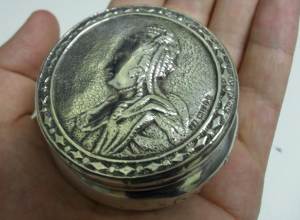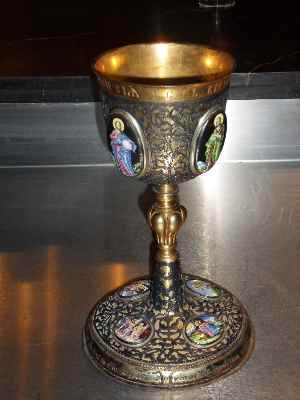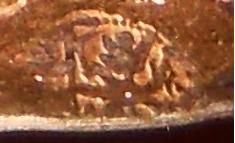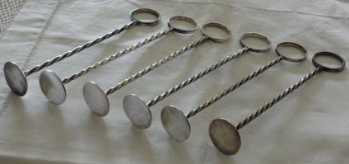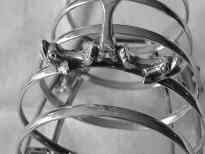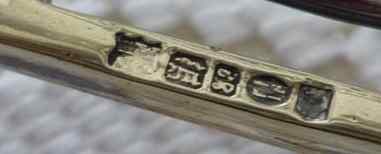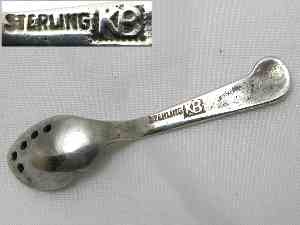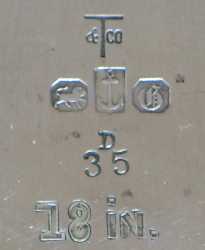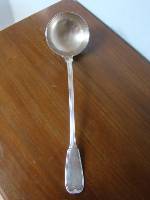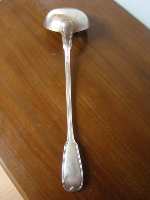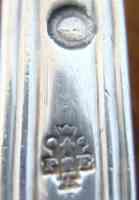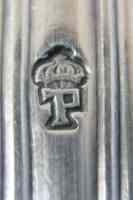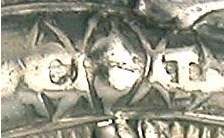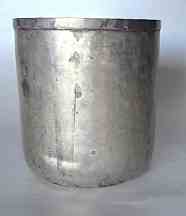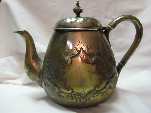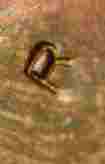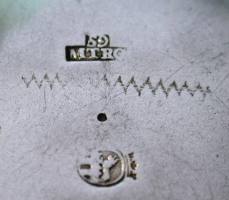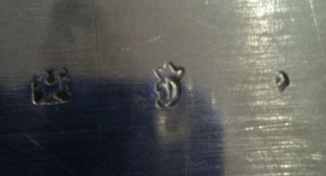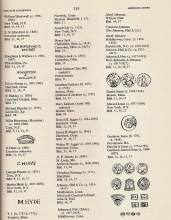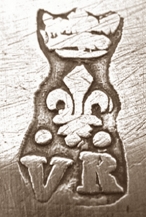
Christophe Ginter presents
an article written in three versions (English, French
and Italian):
The hallmarks of silversmiths' widows in the Kingdom of France 
Les poinçons des veuves d'orfèvres sous l'Ancien
Régime français 
I punzoni delle vedove dei maestri argentieri nella
Francia del XVIII secolo 
.....In the Kingdom of France, no region excluded, no woman in the 18th century could be
appointed a master silversmith. However, many wives of master silversmiths were themselves
daughters of silversmiths and participated in the day-to-day management of the workshop
alongside their husbands. If they rarely practiced the trade, at the least they were
cognizant of the techniques, the accounts, and/or the relationships with the clientele.....
click here  click
here click
here  click
here click
here 
|
Welcome to new ASCAS members:
Lance Bogan - USA
Anne-Françoise Cadoret - France
Neil Eisenberg - USA
Mark Hall - USA
Jolyon Warwick James - Australia
Shirley Nesbitt - Australia
Joyce North - USA
Peter Van Adrichem - Canada
Beth Walker- USA
Members' Window # 70

Pietro Fantazzini and
Giorgio Busetto present:
The Mysterious mark on an Italian coffee pot 
Now, after four years, the little mystery can be solved
and the mark identified. The lozenge with 'R' and 'C'
with an '&' in the middle is the trade mark used by
RICCI & C., Fabbrica Argenterie Posaterie, Corso Acqui
41/A, Alessandria.
Ricci & C. was active in Alessandria since 1931 and
after the introduction in Italy of the new hallmarking
system (law February 5, 1934, n. 305) its production
used the mark "20 AL" (with a "fascio" in the middle
until 1945c.).....
click here 
|
Darren Marais writes:
...I wonder if you can help, I have a very old Antique Victorian
silver plated thimble box. It has marks "J.S, a lion and C F and
a shield with a leopard head".
I believe it may have been made by Charles Fox, famous
silversmith of the 1800s.
Many thanks and kind regards
Darren Marais
Your pill box wasn’t made by Charles Fox. It is an
imported item (presumably from Germany) and its marks signify:
- leopard head = London
- c= date 1898
- F=imported item
- J.S = John George Smith & Co (as importer).
This business of shipping and forwarding agents was founded in
1849 in London and Dover when John Friend (trading as Friend &
Co) went into partnership with John Piddington. In 1865 John
George Smith sr. (son-in-law of Piddington) became proprietor
and was succeeded in 1890 by John George Smith jr. The firm is
noted to have imported a great deal of silver until 1939 (from
1918 was active under the style Continental Daily Parcels
Express Ltd and from 1921 as Continental Express Ltd).
Giorgio Busetto
The marks of your chalice are rubbed and I'm unable to
help you. I try to publish your photos in ASCAS Newsletter, but
I'm doubtful that will be possible to identify your marks.
Giorgio Busetto
The second item is a circular toast rack with four "fish
feet" and two more adorning the handle.
Again the markings are worn and I rather think this item is
silver plate but would appreciate any information you or ASCAS
members could offer.
With best wishes
Sara Dilewski
Both items are silver plate and not solid silver.
The mysterious item bears a mark (indeed not well readable in
your photo) that I believe to be one of the many variants of
John Round & Son (see my web site at
http://www.silvercollection.it/electroplatesilverQR.html).
I don't know what is the use of these items (something to use
with asparagus?).
I hope that someone of ASCAS members will be more informed about
their use.
The rubbed mark on toast rack I believe to belong to Henry
Wilkinson & Co. See my website at
http://www.silvercollection.it/electroplatesilverWZ.html).
Giorgio Busetto
My first idea was a "moustache spoon", but the holes on
the bottom exclude this hypothesis.
Another hypothesis is to use the spoon to collect tea leaves in
the teapot in a modern interpretation of a mote spoon.
Presumably the spoon was made in the USA where so many oddities
were made in 19th century's flatware.
I trust for identification in someone of ASCAS members more
acquainted about the use of these spoons.
Giorgio Busetto
The lion passant, anchor, etc. is the mark of Gorham. The
"D" dates your tray to 1871 (see in my website at
http://www.silvercollection.it/gorhamdate.html).
The T&Co is, possibly, a retailer's mark (Edward Todd & Co used
a similar mark).
I'm don't see any mark referring to silver fineness 800/1000
(and I'm not aware of 800/1000 silver manufactured by Gorham).
Possibly the tray is silver plate
Giorgio Busetto
Mario Galasso writes:
...I'd wish to identify the maker of this ladle bearing 19th
century French marks.
Any help will be highly appreciated.
Mario Galasso
Carolyn Meacham writes:
...I have run across a couple of maker's marks and one hallmark
that I can't identify and I was wondering if any are familiar to
you.
They are:
- (left) on a c. 1900 American piece. It looks like a CT with an
...acorn?... between,
- (center) German c. 1850 - maker?
- (right) looks like a wolf or dog and is on a c. 1890 thimble.
Is it a hallmark?
It's unusual for me to run across this many hallmark mysteries
in one week.
In any event, I would appreciate any help you can provide.
Thanks
Carolyn
Paola Continella writes:
...I research information about the origin of this beaker marked
'800'. I was unable to find any information about its mark.
Thanks in advance.
Paola Continella
Possibly the 800/1000 silver beaker s Italian, but I
don't know its mark. Any suggestion will be welcome.
Giorgio Busetto
Luigi Speziale writes:
...Hi, I have recently become a new member of the association
and prior to this was delighted to see the quality, insight and
intelligence shown on your sight, regarding silver. I am a small
collector of inkwells, writing instruments and related ephemera.
Silver and silver plate inkwells have also given me an
appreciation for silver in general and therefore I collect other
items as you will see in this example...
Here are few photos of a teapot I wish some help on in
identifying maker, origin and date item was made. The height is
6 3/4"/17.15 cm x 9"/22.9 cm (end of spout to end of handle) and
weight of 590 grams. This is all I can tell you. It came with no
provenance.
It seems like silver plate or electroplate but I am not sure.
The insulators on the handle are ivory.
This has stumped me for over 2 years in trying to identify it.
There does not seem to be a listing of the maker's initials
anywhere (S & B) at least the way it's shown in the marks?
Again this is why I seek your help and hopefully you can provide
some.
Thank you.
My warmest regards,
Luigi Speziale
The piece is, almost surely, English and made in
Sheffield. If so, the piece was made before 1896 c. as its mark
bears the "crown", the symbol of Sheffield Assay Office. In 1896
the use of this symbol on silver plate was forbidden to avoid
misunderstanding with sterling silver items.
I'm unable to identify the maker and I trust in the cooperation
of ASCAS members
Giorgio Busetto
Bryan Abbott writes:
....I am curious about this mark which I found on your site. The
HA and 88 Kokoshnik marks I recognize. But what are the other
three marks the "P" and the other mark in Cyrillic?
I have a piece that has similar marks and I am unable to find
any relevant information.
If you can help, I would appreciate your time.
Thank you,
Bryan Abbott
The information about your marks:
1.) Moscow, Kokoshnik in use 1896-1908, 88 Zolotniki = 916/1000
silver content
2.) Master: Aleksejev, Nicolaj Wasiliewitsch 1885 - 1896,
working mostly in salts, flacons and kovhsi in enamel - he is
very well known!
3.) re-assayed, worker´s head with hammer in use1927 - 54,
916/1000 silver content
4.) P in circle = mark for "restored goods", in use 1951
5.)
 = Moskowskaja Juwelirnaja Fabrika = Moscow Jewellers Factory
= Moskowskaja Juwelirnaja Fabrika = Moscow Jewellers Factory
Now you know the following:
This object was made in the year 1896 in Moscow by the well
known silversmith Aleksejev N. W. and was in the year 1951
restored and re-assayed with the communistic mark in the Moscow
Jewellers Factory.
"Postnikov"
Ilsiya Gloova writes:
....Can you help me to identify the marks of this sugar castor?
There is also a strange mark at the bottom which I never saw in
silver hallmarks classification.
Sincerely yours,
Ilsiya Gloova
The maker's mark W.A into an oblong oval belongs to
William Aitken, 37.38 Vyse Street and Eagle Works, 78 Summer Row,
Birmingham. This mark was entered in Chester Assay Office in
1901 and 1902, but a similar mark was used also in Birmingham
Assay Office.
The date letter isn't well readable, but I believe it is around
1905.
You can see the Birmingham mark in my website at
http://www.silvercollection.it/englishsilvermarksXW2.html
The R isn't a mark (possibly, a symbol identifying the model or
the journeyman).
Giorgio Busetto
A mystery that ASCAS members are invited to solve!
Giorgio Busetto
Replies to questions
Charles C. Cage writes:Jim Nord's 1849 Swedish
ladle is indeed from Söderhamn, though the city mark is
upside-down. It shows the city arms of two crossed rifles over a
ship (indicative of the city’s primary industries, arms
manufacture and shipbuilding). The maker "AW" is Anders Wedin.
He was born in Forsa in 1812, and in assumed the Söderhamn
workshop of Erik Rengman in 1836. Unfortunately, he was
apparently less than honest: he was convicted on 26 November
1860 for inferior, unmarked and falsely marked goods, and was
sentenced to two and a half years in jail and fined 50 riksdaler.
His workshop was assumed by Jonas Gustav Lock (1839-1903) in
1864. Ref: Kersti Holmquist, Svenskt Silversmide: Guld- och
silverstamplar, 1850-1912 (Stockholm: Nordiksa Museets, 1995),
p. 250.
Charles C. Cage
Fritz Guercke writes:The punch-ladle from Sweden
was manufactured in 1849 (=T4).
In the book SVENSKT SILVERSMIDE - Guld- och silverstämplar
1850-1912 by Kersti Holmquist you can find 8 different initials
"AW" for 8 different silversmiths, but only two fit to the year
1849:" - Anders Wessmann, Kristianstad. The stamps were used
1839 - 1867.
- Anders Wedin, Söderhamn. The stamps were used 1838 - 1864.
The second one, Anders Wedin, made your ladle. He can be
identified by the mark of Söderhamn, the left mark on your
picture (a ship and two guns crossing).
Anders Wedin has an interesting history: He was born 11.3.1812
in Forsa. He took over the workshop of E. Regmann in Söderhamn
using the stamp "AW" from 1838 to 1864. He became member of the
council of Söderhamn. But his career ended on 26.11. 1860: He
was condemned to 2 ½ year prison and 50 Swedish riksdaler
penalty because of wrong examination of gold works. His workshop
went over to J. Lock in Söderhamn in 1864.
All information are from Kersti Holmquist's book SVENSKT
SILVERSMIDE.
Best wishes
Fritz Guercke
Charles C. Cage writes:H. Dinerstein’s cup is
Spanish. The city mark of a bull over a stone bridge is an
abbreviated form of the arms of the city of Salamanca in
Castille and Leon. "59/MTRO" is the mark of Juan Ignacio Montero,
who served as assayer in Salamanca, 1759-1781. I do not see a
maker’s mark. Ref: A. Fernandez, R. Munoa & J. Rabasco, Marcas
de la Plata Española y Virreinal (Madrid: Antiqvaria, 1999), pp.
96-100.
Charles C. Cage
José Luis Muñoz writes:The marks on H.Dinerstein
cup are Spanish, town of Salamanca, assayer Juan Ignacio Montero,
year 1759 (see an image in my attachment).
Johanna Gehrlein writes:
The tray of Nancy Stuckwisch is - already mentioned by
Giorgio Busetto - a product from Hanau, Germany. It's made by J.
D. Schleissner & Söhne (J. D. Schleissner & Sons). Shown mark's
attributed by "Scheffler" to "Schleissner": Bird's mark = # 453;
crowned letter V = # 469.
The right hand shown mark could be a very bad struck maker's
mark of the well known "Schleissner" sickle.
Johanna Gehrlein
In this column we present a page
obtained from makers' brochures, books, auction catalogs,
advertising or whatever other printed paper, related to silver,
that may be of interest for ASCAS members.
The images will be published at a "low resolution" level and for
private and personal use only
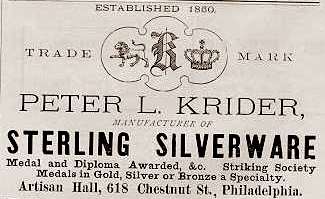
|
This month ASCAS presents an ancient advertising by
PETER L. KRIEDER
manufacturer of
STERLING SILVERWARE
Artisan Hall 618, Chesnut St., Philadelphia
The firm, established in 1850 by Peter L. Krieder,
became Krieder & Biddle (1860-1870c.), Peter L. Krieder
& Co (c.1870-1888, managed Krieder), Peter L. Krieder &
Co (1888-1903, managed by Weber) and Simon Bros Co (from
1903).
In addition to making a regular line of silverware,
flatware and hollowware, the firm was the largest medal
plant in the U.S.
|
"A WORD per MONTH"
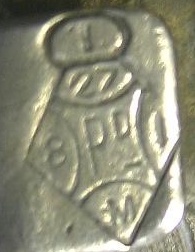
|
LOZENGE MARK
PATENT MARK (BRITISH)
Unlike
silver items, there is no date letter on silverplate
that allows to recognize the date of its manufacture.
For silverplate items the patent's date of registered
models may be useful for an approximate dating.....
more
|
"A SILVERSMITH per MONTH"
|
|
WIENER WERKSTATTE
The Wiener Werkstatte
(Vienna Workshop) exerted an enormous influence on
artists and designers throughout the first part of the
20th century. In 1897 a group of progressive artists and
designers, led by architect Josef Hoffman and painter
Koloman Moser, formed the Vienna Secession which became
the Wiener Werkstätte Produktiv-Gemeinschaft von
Kunsthandwerken, Wien (the Viennese Workshop and
Production Cooperative of Art Works in Vienna) in 1903
when they received backing from a prominent businessman.
This enabled them to equip workshops especially for
working on modern design in a range of applied arts like
glass, metalwork and jewellery....
more
|
"A BOOK ON MY SHELF"
In this column we present books, new
or ancient, dealing with silver in all its aspects (history,
marks, oddities...). This isn't a "book review" but only a fair
presentation of some useful "tools" that anyone may have in the
shelf of his bookcase.
ASCAS members are invited to contribute to this column
(click to enlarge images)
The "book on my shelf" of this month presents:
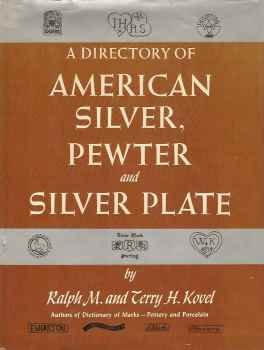
|
Someone wrote about this book:
This is the most comprehensive guide to the subject
ever published. It lists all known makers of American
silver, pewter and silver plate who worked prior to
1900. There are thousands of entries, many more than in
any other book. All the makers' birth and death dates
are given, where possible, as well as the period in
which they practised their craft. All known marks are
listed and cross-indexed. In short, A Directory of
American silver, pewter and silver plate makes it simple
to identify virtually every piece made by the
silversmiths of America.
|
"A CREST per MONTH"
In this column we present images and
descriptions of Crests and Mottoes of British, Irish and
Scottish families as engraved on silver items.
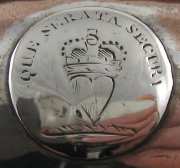
|
DOUGLAS
of Killhead, Baronet.
The crest is described as "A human heart, gules (red),
bezantée (a heraldic term, for a form of decoration,
resembling circular discs, to a division or field
contained in a coat of arms), imperially crowned,
and winged, or (gold)."
The crest is engraved on an unmarked Old Sheffiel
Plate salt cellar.
|
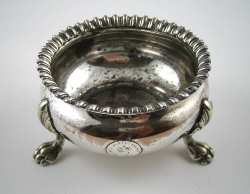 |
Closing our March 2010 edition of ASCAS
Newsletter I hope you have appreciated its content.
Your comments, suggestions and advice will be of great help.
My thanks to Bryan Abbott, Tyr
Baudouin-Lowet de Wotrenge, Charles C. Cage, Paola Continella,
Sara Dilewski, Jayne Dye, Pietro Fantazzini, Mario Galasso,
Johanna Gehrlein, Christophe Ginter, Ilsiya Gloova, Fritz
Guercke, Jolyon Warwick James, Darren Marais, Carolyn Meacham, José Luis Muñoz,
Caroline Padavano, Postnikov, Luigi Speziale, John Yale for
their invaluable contributions.
Giorgio Busetto
Secretary
DISCLAIMER AND PRIVACY POLICY
ASCAS is a community of people having a common
interest in antique silver.
It is a non-profit association without commercial links.
Membership is open to whomever has a true interest in
this subject matter.
ASCAS has no real property and no fees are requested nor
accepted from members.
ASCAS keeps in touch with its members only through
periodical newsletters, e-mails and web-site updating
and ignores and is not responsible for any other
activity pursued by its members.
Likewise, ASCAS is not responsible for opinions,
evaluation and images displayed, and in any form
published or supplied for publication, by its members
who, in any case, maintain the property of their works
and assure the respect of national and international
legislation about Intellectual Property.
ASCAS does not have the full addresses of its members (only
town, country and e-mail address are requested for
membership).
ASCAS handles and protects with care its members' e-mail
addresses, will not disclose the addresses to third
parties, will use this information only to reply to
requests received from members and for communications
strictly related to its activity.
These rules are expressly accepted by submitting the
membership request.
|
|
 newsletter
# 70 MARCH 2010
newsletter
# 70 MARCH 2010
 = Moskowskaja Juwelirnaja Fabrika = Moscow Jewellers Factory
= Moskowskaja Juwelirnaja Fabrika = Moscow Jewellers Factory





